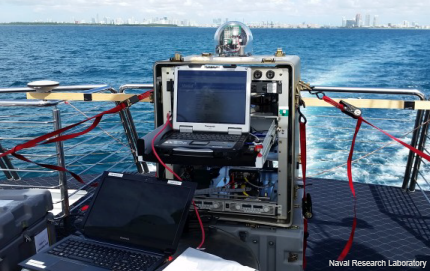NRL demos super-fast ship-to-shore wireless system
The TREC system hits 720 megabits/sec close to shore and holds a still-solid signal more than 22 miles out to sea.

The TREC test assembly aboard the cruise ship outside the Port of Miami.
The Navy, which has been steadily working to increase the speed and range of its shipboard communications systems, took a significant step recently with the demonstration of ship-to-shore system that hit 720 megabits/sec close to port and held its signal, at lower but still solid rates, more than 22 miles from shore.
The Naval Research Laboratory and with Mercury Continuity demonstrated the Tactical Reachback Extended Communications, or TREC, system in the Port of Miami aboard a cruise ship, as part of a cooperative research and development agreement that also included Intelligent Designs, according to an NRL release. http://www.nrl.navy.mil/media/news-releases/2014/nrl-researchers-demo-trec-ship-to-shore-data-link
The 720 Mbps speed represents an orders-of-magnitude improvement over the connections vessels had had in-harbor, NRL said. In the demonstration, one node was installed aboard the ship and one sat atop of 760-foot tall building. The rate was lowered as the ship, Norwegian Cruise Line’s Norwegian Sky, went out to sea, maintaining a 100 Mbps connection at 16 nautical miles and holding the minimum rate at 22 miles, before returning to port and getting back up to 720 Mbps. (As a point of reference, an IEEE 802.11n Wi-Fi connection, found in many homes and offices, has a maximum speed of 600 Mbps but most often delivers real-world speeds ranging from 40 to 100 Mbps.)
ONR said the full-duplex, line-of-sight TREC system, which started as an air-to-ground research effort in 2008, could have both military and commercial applications. Mercury Continuity, commonly known as MC, is planning to release modified commercial TREC systems, capable of delivering high-speed connection more than 25 miles out to sea, later this year.
TREC is another of the Navy’s programs intended to increase the speed and capacity of communications and, by extension, data sharing within the fleet. On a larger scale, the Space and Naval Warfare Systems Command in San Diego is looking to upgrade the Tactical Data Link (TDL) system used aboard Navy ships with the Multi-Functional Information Distribution System on Ship, known as MIDS on Ship, or MOS. That system can use satellite links, an overhead aircraft or ground links to link ships, ground forces and aircraft. SPAWAR recently awarded a $32.6 million contract for the latest version of MOS.